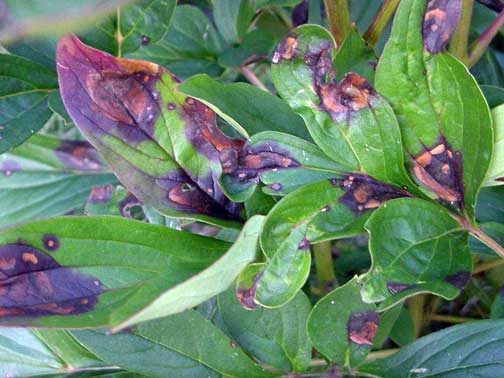Defeating Peony Leaf Blotch
By Carolyn R. Casey, Fairfax Master Gardener
 Peonies are one of my favorite perennials with their beautiful colors, full blossoms and lovely fragrance. They come in a variety of colors, shades of pink, red, purple and yellow to name a few. They bloom in the late spring to early summer. Unfortunately, my peonies have experienced peony leaf blotch.
Peonies are one of my favorite perennials with their beautiful colors, full blossoms and lovely fragrance. They come in a variety of colors, shades of pink, red, purple and yellow to name a few. They bloom in the late spring to early summer. Unfortunately, my peonies have experienced peony leaf blotch.
Peony leaf blotch, also known as red spot, stem spot and measles, will leave peonies looking unattractive and is caused by a fungal pathogen called Graphiopsis chlorocephala, formerly Cladosporium paeoniae. It is found on the stems and foliage of peonies in the spring before they even bloom and is often found on older varieties of peonies.

Beginning peony leaf blotch
It begins as little circular red or purplish spots that develop on the upper surface of immature leaves before the peony blooms. Soon the spots appear as larger glossy, dark purple blotches, and the bottom of the leaves are a dull chestnut brown. The stems and petioles, the slender stems that support the blades of foliage leaves, will have reddish-brown streaks that are raised. The fungus is usually more pronounced on the margins of the outer foliage. In time, the whole plant may be affected with purplish or brownish red spots, and the leaves may become misshapen. In general, the impact of this disease on peony health and survival appears to be minor. As the peony grows, the tissue near the crown may become darkened and depressed. Peony leaf blotch does not cause premature leaf drop or stem dieback. However, it does cause the foliage to become unattractive as the spots become larger.
There are many ways to keep peony leaf blotch from infecting your peonies.
Spacing
It is important to plant peonies 3 to 4 feet apart. The proper spacing of peonies and the pruning out of some of their foliage will increase the air flow and help prevent infection. Good air flow will decrease humidity and help the leaves to dry out. The fungi that cause leaf spots can only infect the peonies when their leaves are wet. Thin out crowded plantings and manage weeds to allow for important air flow and faster drying after rainfall.
Fertilization and Watering. Fertilize and water plants only as needed. This improves plant physiology and limits the excess water pathogens needed to reproduce, germinate and attack these ornamental plants. Watering peonies in the morning allows the leaves to dry out during the day. Drip irrigation will aid in the prevention of peony leaf blotch. Avoid overhead watering of the foliage.

Peony Leaf Blotch infection
Prevention
If you discover that your peonies have developed peony leaf blotch, you will want to take active steps to help prevent a reoccurrence of this fungus in the next year. Because peony leaf blotch overwinters in the infected plant debris, it is necessary to cut plants back at the end of the season and remove all plant debris. Do not put this foliage in your compost. It is important to rake the area around the peony before the new growth appears, removing all leaf material regardless of whether it is from the peony or not. Some home gardeners will cut the stems back at the end of the season when they are still green.
Sanitation
It is important to remove dead and diseased plant parts and to keep your tools clean. Sterilize your pruners with a 70 percent alcohol solution after removing diseased areas. Remove dead or severely diseased limbs, leaves and flowers from your flower bed in the late fall at the end of the season or in early spring before plants break dormancy. Otherwise they become sources of inoculum for disease progression. Late-season peony leaf blotch provides an overwintering inoculum, the part of a pathogen that can cause infection, for next year’s infection of older peony varieties.
Chemical Control
The Plant Disease Clinic of Virginia Tech typically does not recommend that home growers use fungicides for this disease but should depend on cultural practices. Fungicides may be necessary in nurseries where plants are crowded and sprinkler-irrigated. If the disease is severe enough, there are a few options available. Chlorothalonil or tebuconazole can be used if peonies are listed on the label instructions. Liquid Copper fungicide does have peony on the label. Check labels for recommended rates and the timing of applications.
Peonies with their beautiful colors, full blossoms and lovely fragrance, when planted in the right place in your garden and with good preventive care, will continue to grow and flower, enhancing your landscape for several years to come. When purchasing new peonies, look for the peony leaf blotch resistant varieties. You may also want to consider replacing your older peony varieties with the newer resistant ones. Happy Gardening!
Resources
Peony Leaf Blotch, Christine Engelbrecht, Iowa State University Extension and Outreach
Red Spot, Leaf Blotch, or Measles of Peony, Nancy Pataky, University of Illinois Extension
Peony Blotch, Missouri Botanical Garden